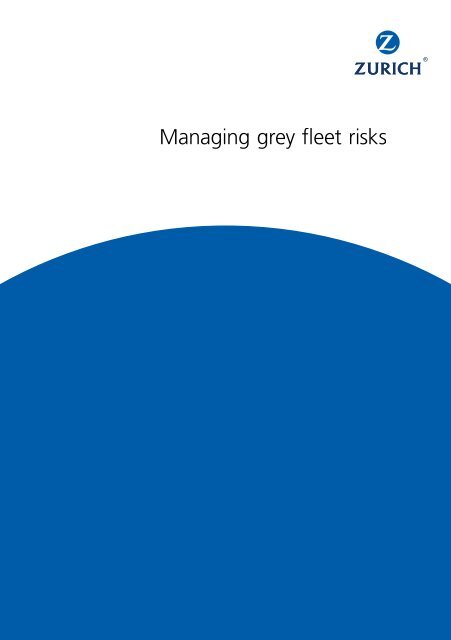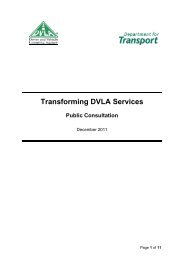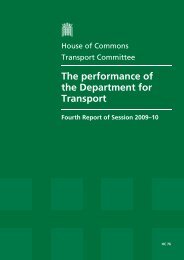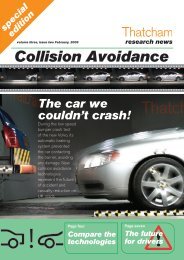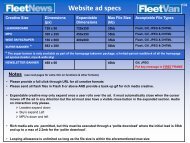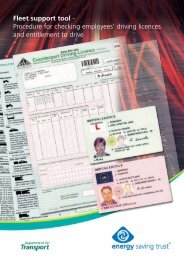Zurich Guide to Managing Grey Fleet Risks - Fleet News
Zurich Guide to Managing Grey Fleet Risks - Fleet News
Zurich Guide to Managing Grey Fleet Risks - Fleet News
Create successful ePaper yourself
Turn your PDF publications into a flip-book with our unique Google optimized e-Paper software.
<strong>Managing</strong> grey fleet risks<br />
Business unit title
Contents<br />
<strong>Managing</strong> grey fleet risks<br />
5 What is the grey fleet?<br />
Why manage your grey fleet?<br />
6 Your Duty of Care<br />
6 The financial argument<br />
7 Carbon footprint<br />
Management challenges<br />
8 The risk management process<br />
– Understand the risks<br />
– Control the risk<br />
– Continue the journey<br />
11 Management responsibility<br />
11 Policies and procedures<br />
What do Companies need <strong>to</strong> manage?<br />
13 The driver<br />
15 Licence and insurance<br />
15 The journey<br />
16 The vehicle<br />
19 Safety in the event of a breakdown<br />
20 In summary<br />
21 More information<br />
22 Appendix<br />
3
4<br />
The grey fleet can be<br />
simply defined as any<br />
vehicle that is used by<br />
an employee for making<br />
a work-related journey.
<strong>Managing</strong> grey fleet risks<br />
Most organisations find it quite challenging <strong>to</strong> manage effectively the<br />
vehicles owned and leased by them. With a significant proportion of<br />
work-related journeys now undertaken in privately-owned or leased<br />
vehicles, how do organisations effectively cope with this aspect of<br />
work-related road risk management?<br />
What is the grey fleet?<br />
The grey fleet can be simply defined as<br />
any vehicle that is used by an employee for<br />
making a work-related journey. This could<br />
be a cash-for-car, a car obtained via an<br />
Employee Car Ownership (ECO) scheme,<br />
a privately-owned vehicle used for<br />
occasional journeys or a vehicle that the<br />
employee has hired outside of any<br />
company-provided scheme. When most<br />
organisations analyse the road journeys<br />
that their employees make on their behalf,<br />
they find a significant number of employees<br />
who they never considered as ‘drivers’ and<br />
who have never seen any of the policies<br />
and procedures relating <strong>to</strong> driving.<br />
The results from management audits<br />
that <strong>Zurich</strong> undertakes for our mo<strong>to</strong>r<br />
fleet cus<strong>to</strong>mers confirms that, in general,<br />
organisations manage their grey fleet<br />
(both the drivers and the vehicles that<br />
they are using) less effectively than they<br />
do with their owned or leased fleet.<br />
5
Why manage your grey fleet?<br />
Your Duty of Care<br />
The ‘Driving at work – managing workrelated<br />
road safety’ guidelines, published<br />
by the Department for Transport (DfT) and<br />
Health & Safety Executive (HSE) in 2003,<br />
make it clear that an organisation has<br />
the same Duty of Care <strong>to</strong>wards all its<br />
employees making work-related journeys<br />
regardless of vehicle ownership, so the<br />
grey fleet needs <strong>to</strong> be managed in exactly<br />
the same way as the owned or leased fleet.<br />
This, as you might expect, raises a number<br />
of challenges that we examine below.<br />
In practice, this means that the Health &<br />
Safety at Work Act, and all the relevant<br />
daughter legislation, applies <strong>to</strong> employees<br />
making work-related journeys, including<br />
the grey fleet, and that organisations<br />
need <strong>to</strong> manage the driving activities<br />
appropriately. This, <strong>to</strong>gether with the<br />
Association of Chief Police Officers (ACPO)<br />
Road Death Investigation Manual 2007 1 ,<br />
and the recent Corporate Manslaughter<br />
and Corporate Homicide Act 2007, mean<br />
that the police and the HSE have a<br />
selection of legislation that they can use<br />
whenever an organisation is suspected<br />
of being negligent in the management of<br />
its employees making work-related road<br />
journeys – typically after a serious collision<br />
has occurred.<br />
In reality, the chances of any investigation<br />
and prosecution are very low, but the<br />
consequences <strong>to</strong> the organisation,<br />
especially in terms of large fines and<br />
reputational damage, are very serious,<br />
so it is imperative that organisations have<br />
a robust set of policies and procedures<br />
<strong>to</strong>gether with a strong audit trail.<br />
The financial argument 2<br />
It is common <strong>to</strong> find fleet and risk<br />
managers focusing on the insured costs<br />
and easily identified uninsured costs, such<br />
as the ‘accidental damage’ (if this is not<br />
covered by their policy) and direct costs<br />
associated with any excess or deductible<br />
associated with their policy, as well as easy<br />
<strong>to</strong> measure issues such as hire costs.<br />
In terms of business impact, the ‘hidden’<br />
uninsured losses, such as those associated<br />
with absenteeism and reputational<br />
damage, are for more important.<br />
The International Loss Control Institute<br />
say that for every £1 paid out by an<br />
insurer, there are between £8.00 – £53.00<br />
in uninsured losses, depending on the<br />
severity of the incident.<br />
1<br />
For more information refer <strong>to</strong> Appendix 1 on p. 21.<br />
2<br />
For more information refer <strong>to</strong> Appendix 2 on p. 21.<br />
6
These ‘hidden’ uninsured losses associated<br />
with collisions do not, of course,<br />
differentiate between vehicle ownership,<br />
so they will be the same for someone in<br />
the grey fleet as for an employee in an<br />
owned or leased vehicle. It follows that it<br />
makes good business sense, regardless of<br />
any legal requirement, <strong>to</strong> manage all<br />
employees, regardless of vehicle ownership,<br />
<strong>to</strong> minimise these ‘hidden’ uninsured<br />
losses and contribute <strong>to</strong>wards the<br />
profitability of the organisation.<br />
The other financial risk associated with<br />
the grey fleet is where an employee is<br />
making a work-related journey is involved<br />
in a collision and is found <strong>to</strong> have either<br />
the incorrect insurance (i.e. they do not<br />
have the appropriate business cover)<br />
or an invalid licence – both of these<br />
issues invalidate any insurance in place.<br />
The employee is committing a specific<br />
offence, and will be prosecuted<br />
accordingly, but in the event of a serious<br />
collision, the probability is that any<br />
claimants will look <strong>to</strong> the organisation<br />
in any civil action, as they had a duty<br />
<strong>to</strong> manage the employee and, most<br />
significantly, they have ‘deeper pockets’.<br />
Carbon footprint<br />
There is increasing focus on what<br />
organisations do <strong>to</strong> manage their<br />
carbon footprint, and there is currently<br />
a lot of focus on driving, both nationally<br />
and also at a fleet management level.<br />
It is relatively easy <strong>to</strong> change vehicle<br />
selection criteria <strong>to</strong> ensure that employees<br />
using owned or leased vehicles have<br />
choice limited <strong>to</strong> vehicles that meet<br />
defined CO 2<br />
emissions (and, equally<br />
importantly, meet pre-defined safety<br />
standards, as discussed later), but much<br />
more challenging <strong>to</strong> dictate vehicle choice<br />
for those employees using their own<br />
vehicle for making work-related road<br />
journeys, which need <strong>to</strong> be included in<br />
any overall carbon-usage calculations.<br />
7
Management challenges<br />
One of the main challenges with any initiatives that are designed <strong>to</strong><br />
make drivers and road journeys safer is that driving is a very emotive<br />
issue, and most drivers believe that they are ‘better than average’<br />
which, statistically, is nonsense. With the grey fleet there is the<br />
additional emotional attachment that people have <strong>to</strong> their cars,<br />
so any initiatives <strong>to</strong> try and ensure that safe cars are being used<br />
needs <strong>to</strong> take this in<strong>to</strong> account.<br />
There is also a big Human Resources (HR)<br />
issue, as many people who opt-out of a<br />
company car scheme do so for tax benefits<br />
or freedom of choice issues, so any<br />
restriction on vehicle choice, or any vehicle<br />
or documentation auditing, is not seen<br />
favourably by the employee but also can<br />
cause sensitivities with HR, especially if the<br />
cash option is seen as a perk and not a<br />
business need.<br />
The risk management process<br />
It is clear from the issues detailed that grey<br />
fleet employees should be treated in<br />
exactly the same way as employees using<br />
owned or leased vehicles, albeit that there<br />
will be more emotional and HR issues <strong>to</strong><br />
overcome <strong>to</strong> achieve this effectively, which<br />
are addressed later. It is important <strong>to</strong><br />
ensure that a proven risk management<br />
process is used <strong>to</strong> manage all work-related<br />
road risks, including the grey fleet.<br />
The risk management process we<br />
recommend is designed <strong>to</strong> ensure that<br />
focus is always on the risks, and that you<br />
strive <strong>to</strong> achieve continuous improvement<br />
in your collision performance, working<br />
<strong>to</strong>wards achieving a crash-free culture<br />
and environment.<br />
8
Assess, analyse and understand<br />
Assess, analyse and understand<br />
stand<br />
Implement selected control measure<br />
Understand the risks<br />
Assess analyse and understand<br />
The first and fundamental step is <strong>to</strong><br />
understand the risks faced.<br />
There are three areas <strong>to</strong> look at:<br />
• Organisational risks (the risks employees<br />
face resulting from the driving activities<br />
associated with the everyday operation<br />
Implement selected control measure<br />
of the organisation) – these can be<br />
analysed by undertaking a<br />
comprehensive management audit.<br />
• Proven risks (risks that have resulted in<br />
collisions) – from a detailed root cause<br />
analysis of the collisions you have.<br />
• Theoretical risks (the risks that a<br />
collision might happen) – from carrying<br />
out work-related road risk assessments<br />
covering the three fundamental areas of<br />
work-related road safety – the driver,<br />
the journeys they make and the<br />
Maintain, moni<strong>to</strong>r and review<br />
vehicles they use.<br />
Assess, analyse and understand<br />
Assess, analyse and understand<br />
Implement selected control measure<br />
Control the risk<br />
Implement selected control measures<br />
Once the risks are fully unders<strong>to</strong>od,<br />
appropriate control measures and<br />
interventions can be implemented <strong>to</strong><br />
tackle specific, identified risks.<br />
It is important that any interventions are<br />
selected using a technically honest<br />
approach based on proven H&S principles:<br />
Maintain, moni<strong>to</strong>r and review<br />
Assess, analyse and understand<br />
• Can the risk be eliminated<br />
Implement selected control measure<br />
(generally a management intervention)?<br />
If this is not possible;<br />
• Can the risk be substituted for a lower<br />
risk alternative (usually a management<br />
initiative)? If this is also not possible:<br />
• Can the risk be reduced (this could be a<br />
management initiative or one focused<br />
on an individual employee)?<br />
9
stand<br />
Implement selected control measure<br />
In all cases, management interventions<br />
should take preference over those focused<br />
at individual employees as these are likely<br />
<strong>to</strong> be more effective at producing a<br />
sustainable reduction in the risk profile.<br />
Organisations need <strong>to</strong> ask<br />
themselves “Do we allow our<br />
employees <strong>to</strong> drive safely?”<br />
Having the best policies and<br />
training available is not enough,<br />
the safety-operational balance<br />
needs <strong>to</strong> be right, with the<br />
operating policies and practices<br />
<strong>to</strong> back this up. If the operating<br />
culture of the business is long<br />
hours, limited or unrealistic<br />
journey times between<br />
appointments, being available<br />
<strong>to</strong> take calls whilst on the road,<br />
then this is in direct competition<br />
with the safety pro<strong>to</strong>cols put<br />
in place and the system will<br />
ultimately fail.<br />
In all instances, risk reduction interventions<br />
must be targeted at specific, identified risks.<br />
Please see the appendix on p.22 for<br />
an example.<br />
Maintain, moni<strong>to</strong>r and review<br />
Continue the journey<br />
Assess, analyse and understand<br />
Implement selected control measure<br />
Maintain moni<strong>to</strong>r and review<br />
Once interventions have been<br />
implemented it is important <strong>to</strong> maintain<br />
the scheme, and the awareness of<br />
all involved, ensuring that everyone<br />
remains focused on the issues,<br />
helping <strong>to</strong> develop and maintain<br />
a good on-road safety culture.<br />
Vehicle maintenance is an important<br />
aspect of the maintenance process,<br />
and it this is one of the key areas the<br />
rganisations find difficult <strong>to</strong> manage<br />
with their grey fleet drivers.<br />
It is also important <strong>to</strong> measure the key<br />
performance indica<strong>to</strong>rs, such as the<br />
collision rate, <strong>to</strong> ensure that the control<br />
measures and interventions selected<br />
are actually reducing the risks your<br />
employees face. This, in itself, provides<br />
10
a challenge with the grey fleet, as you<br />
need <strong>to</strong> rely on the diligence of these<br />
employees <strong>to</strong> inform you of any collision<br />
that occurs whilst they are making a<br />
work-related journey, as you will not<br />
get this information from their insurers.<br />
Lastly, it is vital <strong>to</strong> regularly review the<br />
process <strong>to</strong> ensure that you continue <strong>to</strong><br />
keep focused on the right issues, and <strong>to</strong><br />
continually reassess and tackle lesser risks,<br />
and by doing so achieve continuous<br />
improvement in the safety of your<br />
employees making work-related journeys.<br />
Management responsibility<br />
The first question <strong>to</strong> ask here is who<br />
should have responsibility for<br />
managing the grey fleet? This is often<br />
left <strong>to</strong> the fleet manager, but they rarely<br />
have much influence over grey fleet vehicle<br />
issues, and indeed managing other aspects<br />
of these employees.<br />
In organisations who manage their grey<br />
fleet well, the management responsibility<br />
generally lies with the H&S or HR manager,<br />
or occasionally someone at a senior level<br />
such as the Company Secretary. The thing<br />
they all have in common is that they have<br />
responsibility and/or influence across<br />
the whole organisation, not just one<br />
department. As such, they are able <strong>to</strong><br />
implement risk management initiatives<br />
more effectively ‘across the board’,<br />
including the grey fleet.<br />
Policies and procedures<br />
Most policies and procedures that we<br />
see are <strong>to</strong>o focused on the managed fleet,<br />
and often only include the grey fleet<br />
on a peripheral basis. This is especially<br />
true of most driver handbooks that we<br />
see, which concentrate mostly on the<br />
administrative issues associated with<br />
using an owned or leased vehicle and<br />
have little focus on risk management<br />
issues and even less about issues<br />
associated with the grey fleet.<br />
Whatever policies and procedures are<br />
in place, it is vital that these are fully<br />
embedded in the management systems<br />
and ultimately linked <strong>to</strong> employee<br />
contracts of employment. Doing this<br />
ensures that they can be enforced and<br />
the organisation’s disciplinary procedures<br />
can be used if non-compliance cannot<br />
be managed in any other way.<br />
Policies, procedures and driver handbooks<br />
must apply <strong>to</strong> all employees making<br />
work-related road journeys and, as such,<br />
should focus on key issues such as risk<br />
management, with any particular issues<br />
faced by certain groups of employees<br />
covered in appendices.<br />
11
Regardless of what is contained<br />
in an organisation’s policies,<br />
procedures and driver handbooks,<br />
one of the biggest challenges<br />
faced is getting employees <strong>to</strong><br />
actually read them! Many<br />
organisations get the employee<br />
<strong>to</strong> sign a declaration, either<br />
physically or electronically, <strong>to</strong> say<br />
that they have read, unders<strong>to</strong>od<br />
and will abide by the document,<br />
but in reality very few employees<br />
will have actually read them. This<br />
raises two issues – the first is that<br />
if they have not read them they<br />
are unlikely <strong>to</strong> act on any policies<br />
and guidelines, and the second is<br />
that the organisations cannot<br />
demonstrate that the employee<br />
has read and unders<strong>to</strong>od their<br />
key documentation, just that they<br />
have signed <strong>to</strong> say that they have.<br />
Current best practice is <strong>to</strong> carry out<br />
comprehension checks with all employees,<br />
with 100% compliance required. This<br />
ensures that they have actually read the<br />
relevant documentation, increasing the<br />
chance that they will act on it, and at a<br />
corporate level, the organisation can<br />
produce a robust audit trail and show<br />
that the documentation has been read<br />
and unders<strong>to</strong>od as the employee has<br />
demonstrated 100% compliance in<br />
the checks.<br />
12
What do Companies need<br />
<strong>to</strong> manage?<br />
The situation that most organisations face is that their grey fleet is not<br />
well managed and they face significant challenges, from the employees<br />
and HR, when contemplating change.<br />
Assuming that a proven and effective<br />
risk management programme is in place,<br />
and that you have the necessary policies,<br />
procedures and driver handbooks in place,<br />
and that the employees have actually read<br />
these (see earlier), then you can start <strong>to</strong> focus<br />
on the three fundamental areas of workrelated<br />
road safety – the driver, the journeys<br />
they make and the vehicles they use.<br />
The driver<br />
The driver has the most influence over<br />
whether they are going <strong>to</strong> be involved in<br />
a collision, regardless of ‘blame’, so most<br />
emphasis should be placed here. Whatever<br />
you do for an employee using an owned<br />
or leased vehicle should also be the same<br />
for employees in the grey fleet.<br />
Fitness <strong>to</strong> drive is one of the key areas that<br />
need managing, which will include areas<br />
such as:<br />
• health<br />
• fatigue<br />
• eyesight<br />
• alcohol/drug (medicines and<br />
recreational) use.<br />
Organisations should remember that<br />
anything they do for an employee using<br />
an owned or leased vehicle must also be<br />
offered <strong>to</strong> employees in the grey fleet.<br />
As an example, if eyesight screening is<br />
manda<strong>to</strong>ry for an organisation car driver<br />
(and, of course, it should be), it must also<br />
be manda<strong>to</strong>ry for the user of a private<br />
vehicle, and if the organsiation pays for<br />
one <strong>to</strong> have the test, they must also pay<br />
for the other.<br />
13
Mobile phone use is another area where<br />
uniform management standards must<br />
apply. Best practice is not <strong>to</strong> allow any<br />
phone use whilst driving, but where this<br />
has not yet been implemented, just<br />
because an employee is using a privatelyfunded<br />
vehicle, organisations should not<br />
assume that they are exempt from any<br />
rules on phone use that exist – in fact this<br />
situation is often more difficult <strong>to</strong> manage,<br />
as the employee may have their own<br />
phone and is unlikely <strong>to</strong> have any funded<br />
hands-free equipment.<br />
Risk assessments are another area where<br />
consistent implementation is required.<br />
These are required as part of the risk<br />
management process (see page 8 earlier)<br />
and should give a comprehensive risk<br />
profile of each driver (including their core<br />
competencies) as well as for the journey<br />
and vehicle aspects (covered on pages<br />
15-16 later).<br />
Some organisations only risk assess their<br />
managed fleet employees, as they argue<br />
that these tend <strong>to</strong> be the highest mileage<br />
drivers and hence are at most risk of<br />
being involved in a collision. Others use<br />
the collision his<strong>to</strong>ry of an employee <strong>to</strong><br />
determine who needs assessing. Both of<br />
these approaches are flawed in that, until a<br />
risk assessment has been undertaken, it is<br />
not possible <strong>to</strong> determine where (and what)<br />
the actual risks are. Mileage exposure<br />
and collision his<strong>to</strong>ry are certainly indica<strong>to</strong>rs<br />
of risk, but a good comprehensive risk<br />
assessment will address many other issues<br />
and give an accurate indica<strong>to</strong>r of which<br />
employees are more likely <strong>to</strong> be involved<br />
in a collision. Indeed, the grey fleet driver,<br />
using these simple criteria, is unlikely ever<br />
<strong>to</strong> be assessed, as they tend <strong>to</strong> have lower<br />
mileage exposures and the organisation<br />
rarely has any collision data.<br />
Once the risk assessment process has<br />
been completed, the organisation can<br />
then decide on what the appropriate<br />
interventions are, and again, these<br />
should be applied uniformly regardless<br />
of vehicle ownership. As discussed earlier,<br />
risks should be addressed using a<br />
hierarchical approach (eliminate, substitute,<br />
reduce) with management interventions<br />
given priority as these are most likely <strong>to</strong><br />
produce a sustainable reduction in the<br />
risks faced.<br />
Where interventions focused<br />
on the individual are involved,<br />
there will generally be a cost<br />
implication (whether that is<br />
the employee’s time, organising<br />
an internal training course or<br />
undertaking some externallysupplied<br />
coaching). Any budgets<br />
for risk management must include<br />
the grey fleet, as these drivers<br />
will face similar risks <strong>to</strong> those in<br />
the managed fleet, and need <strong>to</strong><br />
be addressed in the same way.<br />
14
Licence and insurance<br />
3<br />
Licence checking is also an area where<br />
the grey fleet needs <strong>to</strong> be ‘in scope’. Best<br />
practice is <strong>to</strong> check directly with the DVLA,<br />
<strong>to</strong> eliminate any possibility of fraud. This is<br />
possible with employees holding UK or<br />
Irish licences, but not with any other<br />
nationalities (although best practice is<br />
<strong>to</strong> get any foreign nationals <strong>to</strong> take a<br />
UK driving test if they are <strong>to</strong> be driving<br />
here regularly).<br />
It is also best practice <strong>to</strong> use a risk-based<br />
approach for determining the frequency of<br />
licence checks, with drivers at higher risk<br />
of loosing their licence checked more<br />
frequently. These checks need <strong>to</strong> include<br />
the grey fleet drivers <strong>to</strong> minimise the<br />
possibility that they are making workrelated<br />
journeys whilst unlicensed (and<br />
hence uninsured).<br />
One area that is significantly more difficult<br />
<strong>to</strong> manage with the grey fleet is checking<br />
that they have the appropriate insurance<br />
for the vehicle and the types of journey<br />
they will be undertaking. In organisations<br />
where these checks are carried out, it is<br />
most common <strong>to</strong> find some sort of selfdeclaration.<br />
Occasionally physical checks<br />
will be made, although there is a<br />
significant administrative burden<br />
associated with this.<br />
There are a couple of issues <strong>to</strong> consider<br />
here – the first is the person carrying out<br />
any checks needs <strong>to</strong> know what <strong>to</strong> look<br />
for, and what class of business cover is<br />
applicable <strong>to</strong> what the employee is actually<br />
doing when making work-related road<br />
journeys. The second is that there is<br />
nothing s<strong>to</strong>pping an employee cancelling<br />
their policy the day after they show it <strong>to</strong><br />
their employer. A pragmatic approach here<br />
would be <strong>to</strong> undertake annual checks with<br />
some random checks in between.<br />
The journey<br />
The journey has the next biggest influence<br />
over whether an employee is likely <strong>to</strong> be<br />
involved in a work-related collision.<br />
Any travel plans that exist in the<br />
organisation should include the grey fleet<br />
employees. Assessing the need <strong>to</strong> travel is<br />
one of the fundamentals from an H&S and<br />
also an environmental perspective. The<br />
grey fleet need <strong>to</strong> be in-scope here <strong>to</strong><br />
ensure that their journeys are being<br />
managed effectively.<br />
3<br />
For more information refer <strong>to</strong> 3 on p. 21.<br />
15
4<br />
Fatigue is the biggest issue associated with<br />
journeys, so any limits on the <strong>to</strong>tal length<br />
of the working day, including driving,<br />
should include the grey-fleet. It is common<br />
<strong>to</strong> find, despite their (generally) lower<br />
mileage profiles, that the grey fleet driver<br />
faces significant risks in this area (which<br />
should be covered in the risk assessment<br />
discussed earlier). These drivers are often<br />
managers who have opted out<br />
of the company car scheme/are classified<br />
as perk drivers, and tend <strong>to</strong> have a long<br />
working hours culture, so even though<br />
their mileage profile is less, they still face a<br />
significant risk of suffering fatigue and/or<br />
falling asleep at the wheel <strong>to</strong>wards the end<br />
of their working day/on their early morning<br />
journeys if they don’t get sufficient sleep.<br />
The vehicle<br />
After the driver, who is always the most<br />
challenging <strong>to</strong> manage effectively, the<br />
vehicle used by the grey fleet employee<br />
is the most difficult <strong>to</strong> manage, although<br />
has the least influence about whether a<br />
collision is likely <strong>to</strong> occur.<br />
Most policies we see when working with<br />
cus<strong>to</strong>mers have very little in the way of<br />
risk management built in<strong>to</strong> them, and in<br />
general employees using their own vehicles<br />
do not have <strong>to</strong> abide by the principles<br />
of vehicle management that their<br />
colleagues using owned or leased vehicles.<br />
This disparity leads <strong>to</strong> increased risks.<br />
Ideally, the criteria for being able <strong>to</strong> use<br />
a privately-owned vehicle should be clear<br />
and fully align with the organisation’s<br />
wider fleet risk management programme.<br />
There are a few organisations that do<br />
this and are able <strong>to</strong> manage the grey<br />
fleet effectively, as these issues are<br />
covered in contracts of employment as<br />
well as the organisation’s various policies<br />
and procedures.<br />
The first area <strong>to</strong> address is vehicle choice<br />
and fitness for purpose – is the vehicle<br />
suitable for the job that the organisation<br />
is asking the employee <strong>to</strong> do? Where<br />
specialist tasks are involved (e.g. carrying<br />
equipment) then it is often easier for the<br />
employer <strong>to</strong> dictate the type of vehicle<br />
that is acceptable <strong>to</strong> be used, in line with<br />
its managed fleet vehicle selection policy.<br />
For general driving, however, the situation<br />
is much more difficult.<br />
One of the best starting points is from<br />
an H&S perspective – it is reasonable for<br />
a organisation <strong>to</strong> dictate minimum safety<br />
specifications for a vehicle <strong>to</strong> ensure the<br />
safety of an employee, and this needn’t<br />
limit vehicle choice in <strong>to</strong>day’s market.<br />
Some examples are provided on the<br />
next page.<br />
4<br />
For more information refer <strong>to</strong> 4 on p. 22.<br />
16
Stipulate:<br />
Active safety systems<br />
Electronic Stability Control (ESC) can be specified and are available on a wide<br />
variety of vehicles, and this list is increasing as new models are introduced. Antilock<br />
Braking Systems (ABS) should also be seen as a minimum standard (these<br />
are fitted <strong>to</strong> all vehicles with ESC as they make up part of the operating<br />
system), although if these are specified then training is required as there is<br />
widespread uncertainty as <strong>to</strong> what the main benefit of ABS is and how it<br />
operates (this goes for the managed fleet as well).<br />
Passive safety systems<br />
Now widely available. Probably the best way <strong>to</strong> summarise these is <strong>to</strong> use<br />
EuroNCAP ratings as a minimum specification. Most vehicles, with the<br />
exception of some low-volume models, are subjected <strong>to</strong> these tests and there<br />
are a wide range of 5* vehicles available, so again choice should not be <strong>to</strong>o<br />
limited. Some care should be taken when interpreting these test results, as you<br />
there are still differences between different classes of vehicle, so you should<br />
only really compare EuroNCAP ratings within a particular class of vehicle, not<br />
between classes – in general the larger the vehicle the safer it will be.<br />
Age and mileage profile<br />
Should finally be taken in<strong>to</strong> account. This type of data should be available<br />
from the risk assessment, so you can see what issues need managing, but is<br />
not uncommon <strong>to</strong> find very old vehicles being used for work-related journeys.<br />
Older vehicles are likely <strong>to</strong> have fewer active and passive safety systems, and<br />
certainly they will not have the most up-<strong>to</strong>-date systems, and as such their<br />
occupants will face an increased risk of injury either because they cannot avoid<br />
the collision or the vehicle provides less protection in the event of a crash.<br />
Older and higher mileage vehicles, in general, are more at risk of suffering a<br />
malfunction, putting the occupants at risk due <strong>to</strong> the need <strong>to</strong> get the vehicle<br />
<strong>to</strong> a position of safety (e.g. from lane three <strong>to</strong> the hard shoulder of a mo<strong>to</strong>rway)<br />
and also putting them at risk of injury when they are stationary on the<br />
carriageway (many collisions occur on the hard shoulder of a mo<strong>to</strong>rway).<br />
17
Whatever vehicle specification is agreed on for grey fleet employees,<br />
it is vital that they are maintained <strong>to</strong> a minimum standard. There are<br />
two aspects <strong>to</strong> this:<br />
1. The maintenance schedule laid<br />
down by the manufacturer. It is<br />
important that this is followed, using<br />
approved garages, <strong>to</strong> minimise the risk<br />
of malfunction and associated risks<br />
discussed above. For grey fleet<br />
employees there may be a temptation<br />
<strong>to</strong> cut costs and either carry out<br />
servicing/maintenance themselves, or<br />
go outside of the approved garage<br />
network. Whilst this route may lead <strong>to</strong><br />
a good standard of maintenance, it is<br />
difficult or impossible <strong>to</strong> verify, and as<br />
such, from a Duty of Care perspective,<br />
it should not be allowed. Maintenance<br />
records (and MOT certificates where<br />
appropriate) should be checked by the<br />
employer on a regular bases (at least<br />
annually), with random checks being<br />
carried out in the interim. The required<br />
level and standard of maintenance<br />
should be incorporated in<strong>to</strong> any<br />
relevant policies and procedures.<br />
2. Routine maintenance, and this is an<br />
area where organisations have difficulty<br />
managing their owned/leased fleet<br />
drivers. It is important that drivers<br />
regularly carry out their ‘POWER’ checks:<br />
Petrol/diesel (fuel)<br />
Oil levels<br />
Water levels – coolant and wash bottle<br />
Electrics – primarily lights<br />
Rubber – tyres and windscreen wipers.<br />
In reality, very few employees carry these<br />
checks out, but they are vital <strong>to</strong> minimise<br />
the risk that any malfunction associated<br />
with these checks leads <strong>to</strong> a collision.<br />
‘POWER’ checks should be undertaken<br />
at least once per week and before any<br />
long journey.<br />
There is no practical way of ensuring that<br />
routine maintenance is being carried out,<br />
so the best way <strong>to</strong> manage this is by<br />
regular safety communications with<br />
employees and also undertaking random<br />
vehicle audits, where any deficiencies may<br />
be uncovered. This raises problems with<br />
the grey fleet as, being privately-owned, a<br />
common natural reaction of the employee<br />
is <strong>to</strong> say that the organisation has no right<br />
<strong>to</strong> do this. In reality, this view is probably<br />
correct unless the contract of employment<br />
and relevant policies and procedures have<br />
been written with this process in mind.<br />
18
Tyre spotlight<br />
Arguably the biggest safety issue here is checking tyre pressures and<br />
condition. Whenever tyre maintenance companies are invited in<strong>to</strong> an<br />
organisation’s car park <strong>to</strong> undertake tyre checks, it is not uncommon for<br />
them <strong>to</strong> find a significant number (20%+) of vehicles with one or more illegal<br />
tyres, suggesting that routine maintenance is not routinely carried out by<br />
employees. Tyre pressures contribute <strong>to</strong> the overall s<strong>to</strong>pping distance of any<br />
vehicle and also the tyre wear rate and fuel consumption, so this is one of<br />
the fundamental areas that employees should be checking on a regular basis.<br />
When setting guidelines as <strong>to</strong> when <strong>to</strong> change them, best practice is <strong>to</strong><br />
replace them at 3mm as research has shown that performance, especially in<br />
the wet, significantly deteriorates below this figure. Any policy associated<br />
with tyre changing must be applied uniformly across all drivers. There is a<br />
major cost implication for the individual employee, and consideration needs<br />
<strong>to</strong> be made in any cash allowance.<br />
Safety in the event of<br />
a breakdown<br />
An area often neglected with the grey<br />
fleet is breakdown cover – this is normally<br />
provided for owned or leased vehicles and,<br />
because of the safety benefits, it should<br />
also be provided <strong>to</strong> the grey fleet employee,<br />
even though this is another additional<br />
cost. The prime reason for doing this is the<br />
safety benefits of having a breakdown<br />
specialist deal with any maintenance issue,<br />
for example changing a wheel, compared<br />
<strong>to</strong> the risks associated with an employee<br />
attempting even minor repairs at the<br />
roadside, especially on a mo<strong>to</strong>rway.<br />
Some fleets supply additional ancillary<br />
equipment <strong>to</strong> enhance the safety of the<br />
driver – examples would include highvisibility<br />
jackets for use in the event of<br />
an emergency, ‘life hammers’ <strong>to</strong> help cut<br />
seatbelts and break windows following a<br />
collision, and tyre pressure and treaddepth<br />
gauges. If these are being supplied<br />
from a safety perspective then it follows<br />
that these should also be supplied <strong>to</strong> grey<br />
fleet drivers (and indeed <strong>to</strong> users of hire<br />
vehicles). This is another example where<br />
there is a cost implication not necessarily<br />
thought about when setting up any<br />
opt-out scheme.<br />
19
In summary<br />
<strong>Managing</strong> the grey fleet isn’t easy,<br />
and it needs someone with crossdepartment<br />
responsibility <strong>to</strong> be able<br />
<strong>to</strong> implement work-related road risk<br />
management effectively. Policies and<br />
procedures need <strong>to</strong> take in<strong>to</strong> account<br />
the management issues associated with<br />
all employees, not just those in a<br />
company-managed vehicle.<br />
The rationale for managing workrelated<br />
road risks effectively is clear,<br />
both in the managed and grey fleets, <strong>to</strong><br />
meet your Duty of Care, comply with the<br />
relevant legislation and <strong>to</strong> meet your<br />
Corporate Social Responsibility (CSR).<br />
The most compelling reason for most<br />
organisations, however, will be the financial<br />
one, <strong>to</strong> control the uninsured losses<br />
associated with every collision, regardless<br />
of vehicle ownership. This will help<br />
increase the profitability of any business.<br />
The focus on environmental issues is<br />
likely <strong>to</strong> become increasingly onerous<br />
for organisations, so all work-related<br />
journeys, regardless of vehicle ownership,<br />
will need managing <strong>to</strong> help an<br />
organisation manage its carbon footprint.<br />
The key <strong>to</strong> managing all risks that an<br />
organisation faces is <strong>to</strong> use a proven<br />
risk work-related road risk<br />
management process, and not simply<br />
use any risk assessments as a prescriptive<br />
way <strong>to</strong> determine who needs training.<br />
Using proven H&S principles, and<br />
favouring management interventions over<br />
those focused on the individual employee,<br />
will help produce a sustainable reduction<br />
in the risk profile which will ultimately<br />
realise the safety, legislative, CSR and,<br />
above all, the financial benefits that will<br />
be obtained from a sustainable reduction<br />
in the collision rate.<br />
Essentially, organisations need <strong>to</strong> foster an inclusive safety culture in order <strong>to</strong><br />
reduce incidents over time – practical interventions won’t work in isolation.<br />
20
More information<br />
1 Revision of the road death investigation manual.<br />
Fatal road collisions – are you prepared for<br />
an investigation?<br />
2 Financial case for managing work-related<br />
road safety.<br />
3 Why should an employer check driving licences?<br />
4 Top dos and don’ts for managing fatigue.<br />
All of these articles are available <strong>to</strong><br />
download from the information library on<br />
www.zurich.co.uk/riskservices<br />
21
Appendix<br />
As an example, if one of the risk areas identified from the<br />
assessment process is an employee’s high mileage profile,<br />
the risk reduction strategy would be, in this order:<br />
1. Eliminate some of the mileage, which is generally a management<br />
initiative. As an example, sales terri<strong>to</strong>ries could be reorganised.<br />
2. Substitute some of the journeys for ones on public transport,<br />
which is also generally a management initiative. Air and train travel<br />
are both significantly safer than travelling by road.<br />
3. Ensure you have robust policies on fatigue management, also a<br />
management initiative. The biggest risk for high mileage drivers is<br />
falling asleep at the wheel, so policies should include limits on the<br />
maximum length of the working day (including driving), maximum<br />
continuous driving times and break durations (15-20 minute breaks<br />
after 2h driving or sooner if feeling tired).<br />
4. Raise awareness about fatigue issues and provide practical suggestions<br />
on how <strong>to</strong> manage this, also a management intervention.<br />
5. Provide guidance & training on effective route planning, <strong>to</strong> ensure<br />
journey times are minimised.<br />
6. Provide guidance & training on effective schedule setting <strong>to</strong> ensure<br />
that journeys are planned efficiently.<br />
7. Provide guidance & training on how <strong>to</strong> attain the correct seating<br />
position, as incorrect posture will lead <strong>to</strong> the early onset of fatigue.<br />
As you can see, even though this was identified as a risk from an<br />
individual assessment process, the prime risk reduction recommendations<br />
are those focused on management initiatives.<br />
22
PP126028A01 (ZRE0007.01) (04/<br />
08)<br />
<strong>Zurich</strong> Management Services Limited<br />
Registered in England and Wales No.2741053.<br />
Registered Office: The <strong>Zurich</strong> Centre, 3000 Parkway,<br />
Whiteley, Fareham, Hampshire PO15 7JZ.


